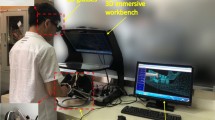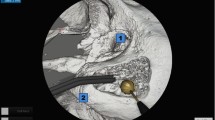Abstract
It is difficult to implement a stable and realistic haptic simulation for cutting rigid objects that is based on a damping model because of an inevitable conflict between stability and high output force. This paper presents passivity techniques to show that an excessive damping coefficient causes the output stiffness to exceed the maximum output stiffness of the haptic device, leading to instability. By analysing the damping model of a haptic dental-training simulator, we construct a relationship among the damping coefficient, position resolution, sampling frequency, human operation, and the maximum achievable device stiffness that will still maintain device stability. A method is also provided to restrict the output stiffness of the haptic device to ensure stability while enabling the realistic haptic simulation of cutting rigid objects (teeth) that is based in a damping model. Our analysis and conclusions are verified by a damping model that is constructed for a dental-training haptic display. Three types of haptic devices are used in our analysis and experiments.









Similar content being viewed by others
References
Adachi Y, Kumano T, Ogino K (1995) Intermediate representation for stiff virtual objects. In: Proceedings of IEEE virtual reality annual international symposium, Research Triangle Park, NC, March, pp 203–210
Adams RJ, Hannaford B (1999) Stable haptic interaction with virtual environments. IEEE Trans Rob Autom 15(3):465–474
Basdogan C, Ho C, Srinivasan MA (1999) Simulation of tissue cutting and bleeding for laparoscopic surgery using auxiliary surfaces. In: Proceeding of the medicine meets virtual reality VII conference, San Francisco, CA
Colgate JE, Brown JM (1994) Factors affecting the Z-width of a haptic display. In: Proceedings of IEEE international conference robot automat, Los Alamitos, CA, pp 3205–3210
Hannaford B, Ryu JH (2002) Time-domain passivity control of haptic interfaces. IEEE Trans Rob Autom 18(1):1–10
Mahvash M, Hayward V (2003) Haptic simulation of a tool in contact with a nonlinear deformable body. In: Ayache N, Delingette H (eds) IS4TM: International symposium on surgery simulation and soft tissue modelling. Lecture notes in computer science (LNCS 2673). Springer, New York, pp 311–320
Minsky M,Ouh-Young M, Steele O, Brooks FP, Behensky M (1990) Feeling and seeing issues in force display. Comput Graph 24(2):235–243
Salcudean SE, Vlaar TD (1997) On the emulation of stiff walls and static friction with a magnetically levitated input/output device. Trans ASME J Dyn Syst Meas Contr 119(1):127–132
Tanaka A, Hirota K, Kaneko T (1998) Virtual cutting with force feedback. In: Proceedings of virtual reality annual international symposium, vol 199(8), pp 71–77
Wang D, Zhang Y (2004) Effect of haptic device’s position resolution on stability. In: Proceedings of EuroHaptics 2004, Munich Germany, 5–7 June, pp 377–380
Wang D, Zhang Y, Wang Y, Lee Y-S, Lu P, Wang Y (2005) Cutting on triangle mesh: local model-based haptic display for dental preparation surgery simulation. IEEE Trans Vis Comput Graph 11(6):671–683
Mark WR, Randolph SC, Finch M, Van Verth JM, Taylor RM II (1996) Adding force feedback to graphics systems: issues and solutions. In: Proceedings of SIGGRAPH 96, New Orleans, Louisiana, August 4–9, pp 447–452
Zhang Y (1990) Metallic cutting theory and tool. National Defence Industry Press, Beijing, pp 163–180
Acknowledgments
This research received support from the National Science Foundation of China under the grant no. 50575011.
Author information
Authors and Affiliations
Corresponding author
Rights and permissions
About this article
Cite this article
Liu, G., Zhang, Y., Wang, D. et al. Stable haptic interaction using a damping model to implement a realistic tooth-cutting simulation for dental training. Virtual Reality 12, 99–106 (2008). https://doi.org/10.1007/s10055-008-0094-x
Received:
Accepted:
Published:
Issue Date:
DOI: https://doi.org/10.1007/s10055-008-0094-x




